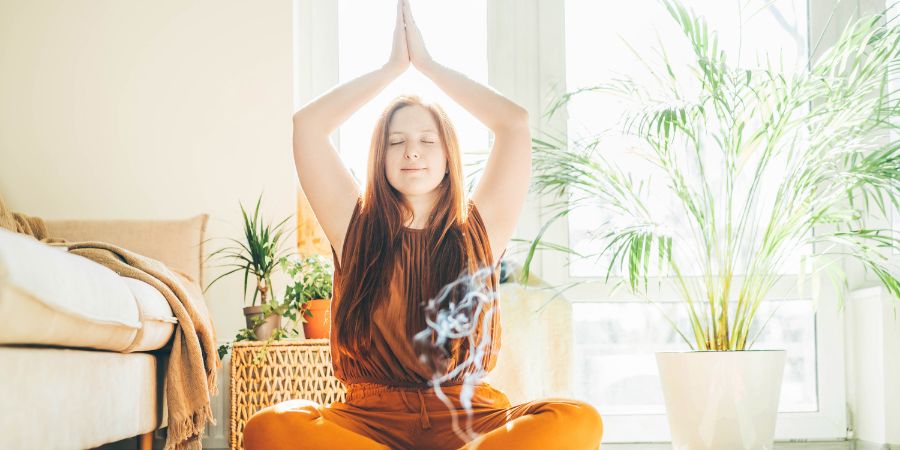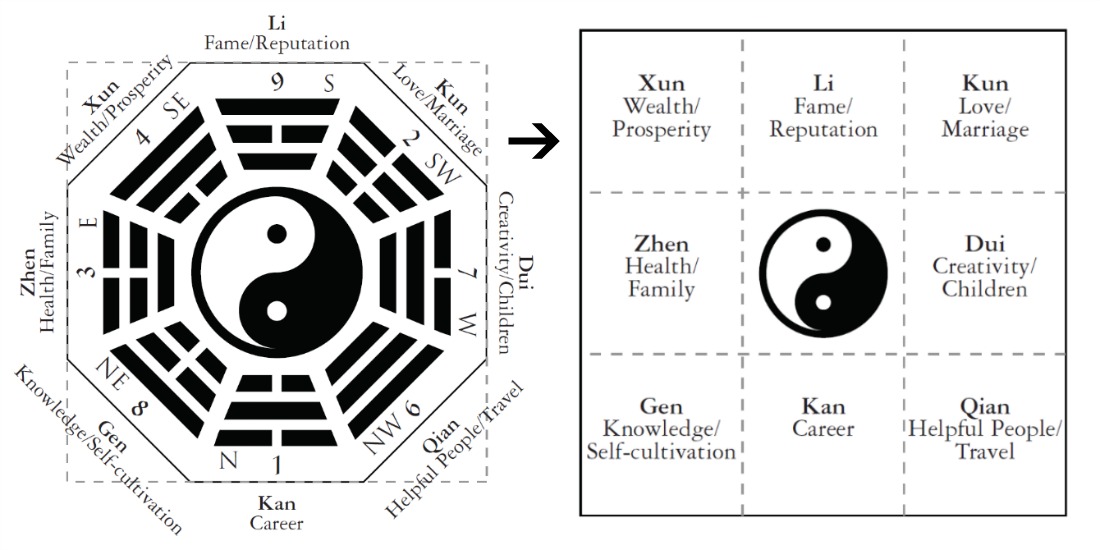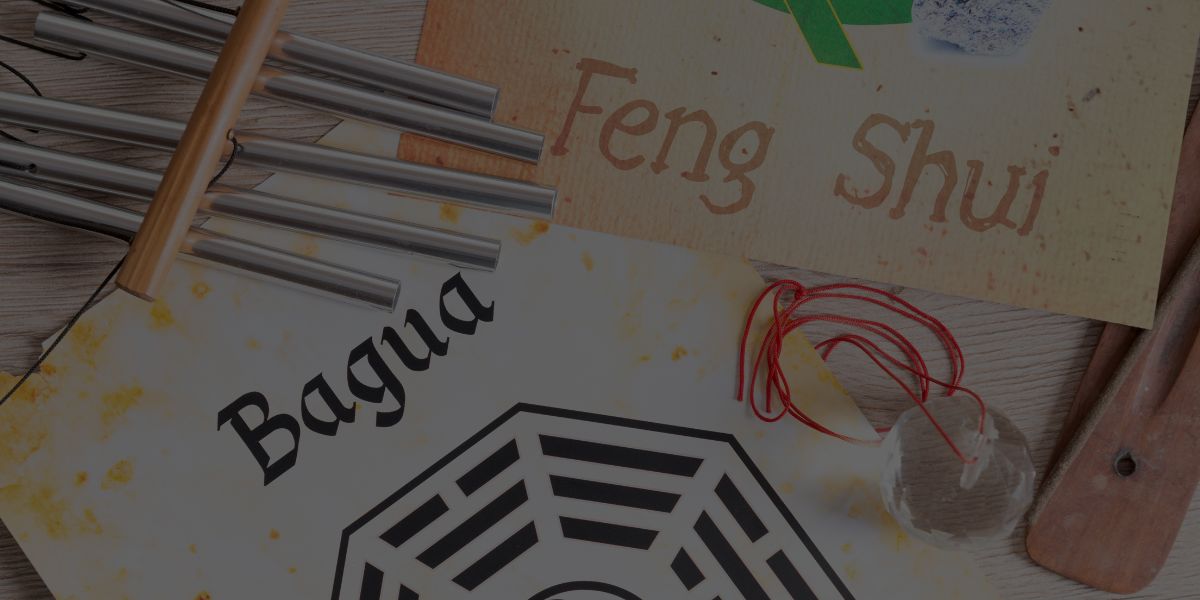Updated 2024.
- The Bagua map is a tool used to assess how Ch’i, yin and yang forces, and the Five Elements operate in your clients’ rooms.
- By correctly using the Bagua map, you can identify any energy imbalances within the space(s) and then use a cure to help rid that negative energy.
- There are 2 types of Bagua maps – the traditional, octagonal map and the modern, square map. Though their appearances differ, the information within both maps is the same.
- A Bagua map has: 8 different guas (which each have their own name and attributes), 8 groups of lines known as trigrams (comprised of the female yin and male yang energies), and the tai ji (yin yang) symbol at the center.
- Guas also have “flying star numbers” (a.k.a. “magic numbers”), their own compass direction, and association with: an element, body part(s), person(s), color(s), and aspect of nature.
- All 9 sections of the Bagua map require EQUAL attention.
- The 5 steps for applying the Bagua map in Feng Shui design are: (1) obtaining a copy of the floor plan, drawn to scale (or drawing it yourself if otherwise unavailable); (2) drawing the Bagua map over top of the floor plan; (3) placing the map on top of the floor plan; (4) identify where all of the guas are; (5) and locating where energy flow is stagnant so it can be corrected with a cure.
- Each floor of the home requires a different Bagua map layer.
- When layering the Bagua map, always do the main floor first.
- Layered readings – where the Bagua map is first applied to the whole floor, and then separately in each individual room – makes for a more comprehensive and cleaner energy reading, as well as better boost specific guas in the home.
- Only use a Feng Shui cure AFTER evaluating all aspects of your client’s lifestyle and goals.
- You can properly identify your Bagua direction by facing your home head-on and locating the front door, which is considered to be the “facing direction” of your home.
- QC Design School’s self-paced, online Feng Shui Design Course has an entire section devoted to the Bagua map, which will teach you everything you need to know to use it in your day-to-day and/or professional life.
- By training with QC’s self-paced, online courses, you can earn your globally-recognized certification and start a successful home design career in as little as 3 months.

Introduction
The Bagua map is an essential tool for Feng Shui design. You can use it for spaces of all sizes – from the entire home to just a small office desk! Whether you’re completing a Feng Dhui design course (such as the online one offered at QC Design School) or you’re a design hobbyist, you’ll be using this map for everything.
Now, after taking an initial look at the map, you’re probably overwhelmed with the wealth of information. But don’t worry! We’ll break it all down for you right now.
Read on to learn all about the Bagua map and how to use it!
What Is The Bagua Map?
The Bagua map is a tool used to assess how Ch’i, yin and yang forces, and the Five Elements operate in your clients’ rooms. It allows you to pinpoint where you could make adjustments in order to ensure good Ch’i flow. From there, you then use cures to correct any energy imbalances present in the space(s).
Each section of the map has their own unique characteristics. If you apply cures that properly reflect these properties in areas that need attention, you’ll balance out the Ch’i in no time!
Helpful Readings
Become a certified Advanced Feng Shui Design Professional™ (AFDP™)
Get trained, certified, and booking your first client in as little as 3 short months!
What’s On The Map?
There are two versions of the Bagua map. Although they may look different, they provide the same critical information!
Let’s jump into what the traditional Bagua map looks like:
- The 8 different “slices” of the pie (gua) each have a name and represent a different attribute (or “life situation”).
- Immediately around the tai ji (yin yang) symbol, there are 8 groups of lines known as trigrams. Each trigram is a different combination of solid and broken lines. The solid lines represent yang (male) Ch’i and the broken lines represent yin (female) Ch’i.
- The guas also have “flying star numbers” (or “magic numbers”) associated with them. They determine whether the Ch’i should be more yin or yang, in order to produce a favorable atmosphere in a particular space.
- Each gua has a compass direction. The south is at the top and the north is at the bottom. In traditional Chinese culture, the south represents the heavens while north represents earthly living.
- Each gua is also associated with an element, body part(s), person(s), color(s), and an aspect of nature.
- The tai ji symbol lies in the center. It represents balance and harmony of all the guas. It also represents personal health and well-being, and reminds you to consider the clients’ needs at the center of the space.
As seen in the second Bagua map, the traditional octagonal map has simply been adapted into a square. All the information remains the same – however, it’s much easier to read when used with modern floor plans! Just remember that, whatever the shape, each of the 9 different sections (tai ji is one of them) requires equal attention!

How To Apply The Bagua Map in Feng Shui Design
- Obtain a copy of the floor plan, drawn to scale. If your client does not have a floor plan readily available, you’ll have to draw one yourself.
- Draw the Bagua map on top of the floor plan. Choose a color that makes the Bagua easier to see over the floor plan.
- Place the map on top of your floor plan. The front door is the key focal point. You need to align the bottom of the bagua map along the same axis as the front door.
- After you draw the bagua map correctly over your clients’ floor plans, you can identify where the guas are.
- Locate where energy flow is stagnant. From there, you can then fix it using Feng Shui cures related to the properties on the Bagua map.
Pro Tip: Having trouble drawing your floor plan? Here are 6 floor planning apps and software that can help!
Layering The Bagua Map
If you’re designing a home with more than one level, you’ll have to layer your Bagua maps.
As a rule of thumb: always do the main floor first, and then move on to the upper floors afterwards. Also, if you apply Feng Shui in more than one room in a given property, you’ll increase optimized energy flow. After the Bagua map readings are all complete, you can then make adjustments on each floor individually (same as you would the main).
Layered readings also help individually boost a specific gua in each area of the house. For example, if your clients want to boost their health, you can apply the Bagua map to the whole floor – and then again in each room.
The Health gua connects to the eastern direction. Furthermore, it has the color green and the element of wood as its attributes. So, you can suggest adding some live plants to that side of the room to activate the wood energy. This is an effective way to boost the gua throughout the home!
Start your career in home design, all from the comfort of home
Train with QC Design School’s self-paced, online certification courses!
Examples of Readings
Underlying issues that previously flew under your client’s radar may come to light during your consultations. You can use Feng Shui to improve the energy flow of the spaces and the way people interact and use them.
Here are a few examples:
- Cluttered center space: This space is linked to the tai ji. So, keep it clear of clutter! Since it represents Personal Health, keeping it uncluttered will allow for the free flow of Ch’i energy. Also, warm yellow colors are particularly useful here. After all, this color represents the sun and its life-sustaining force! In terms of cures, it can be hard to place cures in the center of the room, as they may need to rest on big furniture. Heavy, imposing furniture can block Ch’i – and this is why adding yellow (perhaps via the carpet) is a great option!
- A bathroom with an unusual element: If the bathroom rests within the fame and reputation gua, you may notice that the associated element is fire. For obvious reasons, bathrooms are usually associated with the water element… Meaning, this could cause an energy clash if not handled properly. If the space is in need of energy enhancement, this is an easy fix: simply add some red candles (to tackle two birds with one stone)! If it doesn’t suit the design style, you could nix the fire element and add red hand towels and carpets instead. You may even wish to add wicker baskets and plants in order to neutralize the strong water element.
Feng Shui Cures
Keep in mind that Feng Shui is complex. As such, you should suggest cures ONLY after evaluating all aspects of your clients’ lifestyle. The practice isn’t only about furniture placement or adding lucky charms! Rather, your clients’ health, relationships with other inhabitants, and other considerations are important, too.
Pro Tip: Should you use a cure, however, here are 4 classic ones often used in Feng Shui design!
Bagua Map FAQ
How do I know my Bagua direction?
A: To determine your Bagua direction, stand in front of your house or apartment and locate the front door. The direction that the front door faces is considered the facing direction of your home. You can also use a compass to determine the exact direction.
What if my floor plan is not a perfect square or rectangle?
A: No worries! Simply adjust the shape of your Bagua map according to the shape of your floor plan. As long as you align it with the front door, you’ll still be able to identify each gua and make adjustments accordingly.
How often should I update my Bagua map?
A: You can update your Bagua map as frequently as you like! It’s a good idea to do so whenever there are changes in your living space, such as a renovation or furniture rearrangement. Additionally, it’s always a good idea to refresh the energy in your home every year by doing a thorough cleaning and decluttering session.
Remember: Feng Shui is all about creating balance and harmony within your living space. So, don’t be afraid to make adjustments when needed!
How do you activate Bagua?
A: Activating the Bagua involves enhancing each area of your home with elements that correspond to its energy.
Start by identifying the guas (areas) on your Bagua map and their associated elements, colors, and symbols. For instance, adding plants or wooden objects can activate the Family and Health gua, as it is associated with the Wood element. Similarly, placing objects in pairs (such as candles or artwork) can enhance the Love and Relationships gua.
Be intentional with your choices and focus on the intention or goal you have for each area. After all, Feng Shui is about creating positive energy – so, choose items that resonate with you and support the energy you wish to cultivate!
Is there such thing as a Bagua map calculator?
A: While there isn’t a specific Bagua map calculator, there are many tools and guides available to help you create your own Bagua map accurately! Simply follow the step-by-step instructions provided earlier in this article.
And if you’re uncertain, numerous online resources and apps can guide you in determining the layout and energy flow of your home. Just remember that understanding and personalization are key. Take your time and trust your intuition during the process!
Can I find a Feng Shui Bagua map with directions?
A: Yes, there are many resources available online that provide a Bagua map with direction indicators. Some may even come with additional information and tips on how to best utilize the Bagua map in your home.
For example, QC Design School’s Feng Shui Design Course offers an entire section in Unit B about the Bagua map. As part of this lesson, you’ll learn the correct way to create one based on the area(s) of the home.
Regardless of how and where you get your Bagua map, just be sure to choose one that aligns with your specific goals and intentions for using Feng Shui in your space!

Pretty cool the fact that you can map each area of your house with such an easy to use map.
For me I’ve instictively placed my desktop in the weatlh / prosperity section which is exactly what I want.
Great stuff.
The southwest corner of my home is actually not the bedroom , which is the kids toy room. Do I strictly lay this map over the floor plan of my house, as is, or do I adjust for which are of the house is actuallyN, S, W and E.?
My front door is located at Helpful people and Travel Gua. From the left side of the front door, there two rooms and one other bedroom is directly to the front door. How can the Ba Gua map be applied?
One more question, please. Can Ba Gua map be applied for each room, not simply to the whole apartment? For instance, the kitchen can have 8 Gua, the bedroom can have 8 Gua as well. Any thoughts?
Hey CC,
Thanks for taking the time to read our article and leave such a thoughtful comment. With regards to your second question, you can use the Bagua map for an entire home, entire levels, or each individual room. We’d recommend doing further reading/research into using the Bagua map correctly within individual rooms of your home, as this will help you get a better idea of what you’ll need to do in order to ensure proper energy flow and maximum benefits.
With regards to your first question, it’s a little more difficult for us to provide accurate information, as it would be more beneficial for us to be able to physically see the layout of your front door and the rooms nearest to it. To get the most accurate insight, we’d either recommend seeking out the expertise of a Feng Shui Consultant, or enrolling in our Feng Shui Design Course and becoming a certified Consultant yourself! 😀
If interested, you can find all of the information on this certification course here: https://www.qcdesignschool.com/online-courses/feng-shui-design/
If you have any questions about this course, please feel free to ask them here, or simply email our awesome Student Support Team at info@qcdesignschool.com. Thanks again, CC, and we hope you have a wonderful day!
All the best,
The QC Team
this sounds like black hat method & not TRADITIONAL Bagua because, in traditional method the bathroom is never activated.
My question is this. My front door was moved and now in another room. Which direction do I use the current orientation or the original? Thanks so much! Andria